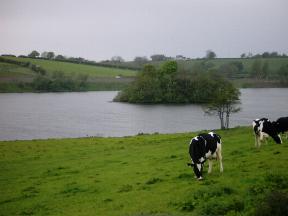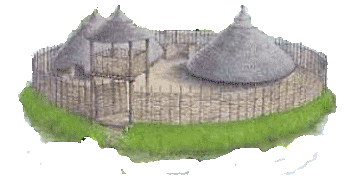|
|
The
term Crannog refers to small islands often artificial, remains of them can be found on
many of Ireland's lakes, the name is derived from the old Irish
'crannóc' from crann, tree. These islands in most cases were
fortified and lived on by people as recently as the 17th century,
some may have been constructed on wooden poles inserted in the lake
bed, understandably none of these have survived. Many good examples
of crannogs are to be found around Ireland. The illustration on
the right shows the crannog in the lake at Loughbrickland
County Down, this was inhabited by the Maginneses of Iveagh
until they built a castle on the shore.
small islands often artificial, remains of them can be found on
many of Ireland's lakes, the name is derived from the old Irish
'crannóc' from crann, tree. These islands in most cases were
fortified and lived on by people as recently as the 17th century,
some may have been constructed on wooden poles inserted in the lake
bed, understandably none of these have survived. Many good examples
of crannogs are to be found around Ireland. The illustration on
the right shows the crannog in the lake at Loughbrickland
County Down, this was inhabited by the Maginneses of Iveagh
until they built a castle on the shore.
Crannogs have been used by man
probably as far back as 4,000 BC, evidence from Scotland proves
they were in use by 3,200 BC. They are usually round or oval in
shape and varied enormously in size. Often they were approached
by a causeway from the mainland, it is probably fair to assume that
the entrance would have been protected by some form of gate house .
The crannog afforded protection not only from unfriendly neighbours
but wild animals also. .
The crannog afforded protection not only from unfriendly neighbours
but wild animals also.
There are a few reconstructed
Irish Crannogs around Ireland one is located 10 km east of Quin,
County Clare, adjacent to 16th century Craggaunowen Castle, another
Irish Crannog is scheduled to be built at Castle
Espie wetlands bird sanctuary in County Down belonging to the
Wetlands Trust. |

 small islands often artificial, remains of them can be found on
many of Ireland's lakes, the name is derived from the old Irish
'crannóc' from crann, tree. These islands in most cases were
fortified and lived on by people as recently as the 17th century,
some may have been constructed on wooden poles inserted in the lake
bed, understandably none of these have survived. Many good examples
of crannogs are to be found around Ireland. The illustration on
the right shows the crannog in the lake at
small islands often artificial, remains of them can be found on
many of Ireland's lakes, the name is derived from the old Irish
'crannóc' from crann, tree. These islands in most cases were
fortified and lived on by people as recently as the 17th century,
some may have been constructed on wooden poles inserted in the lake
bed, understandably none of these have survived. Many good examples
of crannogs are to be found around Ireland. The illustration on
the right shows the crannog in the lake at  .
The crannog afforded protection not only from unfriendly neighbours
but wild animals also.
.
The crannog afforded protection not only from unfriendly neighbours
but wild animals also.